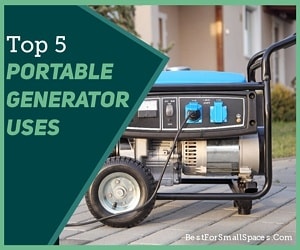
Portable generators are extremely useful pieces of equipment that can really save the day during a power outage. Whether you use a portable generator for Rving, camping, backyard parties, or have one ready and waiting for emergencies, then you should practice safety measures to ensure you and others are not at risk.
Also, it is essential to read the safety instructions that were provided with the generator. This will help ensure you are operating and storing the unit correctly and safely. Below, we have compiled some portable generator safety tips and checklist to guide you in the right direction on how to make the most of these useful machines, as a safely as possible.
Are Portable Generators Dangerous?
When using portable generators, there are some critical dangers to be aware of. These include carbon monoxide hazards, electrical hazards and fire hazards. To ensure safe and proper use of any generator, there are three key factors to consider.
- Firstly, never use a generator indoors! They are strictly designed for outdoor use only!
- Secondly, never plug a generator directly into a wall outlet, because it will produce too much electricity.
- And also, never store a generator indoors, because it is a potential fire hazard.
Can You Run A Portable Generator in the Rain?
The answer to this is always no! Wet weather can not only cause damage to a generator but also pose shock risks or even electrocution. When you use a generator during wet conditions, safety precautions are necessary. Operating a generator is possible under dry and safe conditions, through the use of pop up tents or canopies.
How Far from a House Should a Generator be?
It is safe to operate a generator anywhere from 20 to 25 ft away from a house or a building. This may seem a little far, however, the use of a heavy-duty extension cord will provide the proper set up. Also, use an outdoor cord that is made of quality all weather materials.
Along with keeping the generator 20 to 25 ft from the building or house, it is important to keep the generator in open spaces. Confined spaces pose risks of carbon monoxide poisonings. It is essential to operate a generator in open, well ventilated areas.
General Checklist for Portable Generator Safety Tips
Keep it Dry
Firstly as mentioned before, if it is raining take proper measures to keep the generator dry. This is achievable by using pop up canopies or tents to protect the generator from water damage and protect others from electrical hazards. Also, make sure to place the portable generator on level ground. If the generator is on a slope, it may not function properly and cut off.
Be Aware of Carbon Monoxide Poisoning
Be aware of the dangers of carbon monoxide. Carbon monoxide is odorless and silent, so it is extremely important to never use a generator inside or even near enclosed areas. When referring to indoor use, this also includes basements and garages. Common signs of carbon monoxide poisoning include dizziness, sickness, or weakness. Do not stay inside. It is critical to find a source of fresh air immediately upon discovering these symptoms.
Avoid Toxic Fumes
When using any portable generator, large or small generators, make sure that the generator exhaust is pointed away from any and all windows and vents. If not, fumes will enter the home or building, which will smell and cause health issues. This is especially important when in use in confined spaces, as there is less area to release the fumes.
Store Away From Flammables
Store generators and all flammable components in appropriate containers outside of living areas. Never store them near hot water tanks or furnaces as the heat source can ignite the exhaust fumes emitted from the device. Fire hazards are a serious threat to not only the origin of the fire, but surrounding areas.
Don’t Overfill Gas Tank
Also, never overfill a portable generator’s gas tank. When temperature increases, fuel expands, which means you don’t want an overfilled tank when the generator is in use. Overflowed gasoline poses its own risks and could become a potential fire hazard.
Follow Safety Instructions
Read the safety manual provided with the generator. Be aware of the dangers and take safe, responsible steps to use portable generators for emergencies and many other great uses!
This checklist gives some insight into the dangers of these useful machines. As with anything, there are certain ways to use generators safely to not only make the most out of what they can provide, but also prevent any potential hazards. With the right safety precautions, they can provide a lifetime of power for all of life’s important moments.






